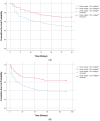Early Urine Output in the Emergency Room as a Prognostic Indicator for Critically Ill Patients Undergoing Continuous Renal Replacement
- PMID: 40566520
- PMCID: PMC12194583
- DOI: 10.3390/life15060866
Early Urine Output in the Emergency Room as a Prognostic Indicator for Critically Ill Patients Undergoing Continuous Renal Replacement
Abstract
Objectives: The impact of initial emergency room (ER) factors on survival and renal function in critically ill patients undergoing continuous renal replacement therapy (CRRT) remains unclear. This study aimed to evaluate whether these initial factors influence survival and renal recovery in such patients.
Methods: This single-center, retrospective study included 190 critically ill patients admitted to the intensive care unit (ICU) via the ER for CRRT between 1 March 2018, and 31 May 2021. Clinical parameters, including urine output, estimated glomerular filtration rate (eGFR), and serum neutrophil gelatinase-associated lipocalin (NGAL), were assessed. The primary outcomes were 30-day and 90-day mortality, while secondary outcomes included 30-day and 90-day RRT-free durations.
Results: Patients with low urine output (LUO, defined as the average of <0.5 mL/kg/h over 6 h) were significantly associated with higher 30-day and 90-day mortality rates. Multivariable Cox regression analysis revealed that the LUO group had an increased risk of 30-day and 90-day mortality (hazard ratios: 1.935 and 2.141, respectively) compared to the high urine output (HUO, defined as the average of ≥0.5 mL/kg/h over 6 h) group. No significant association was observed between mortality and initial eGFR or plasma NGAL levels. However, the HUO group and patients with initial eGFR ≥ 30 mL/min/1.73 m2 had longer RRT-free durations at 30 and 90 days. Plasma NGAL levels did not significantly correlate with RRT-free durations.
Conclusions: Initial 6-h urine output in the ER is a significant predictor of 30-day and 90-day mortality in critically ill patients undergoing CRRT.
Keywords: 30-day mortality; 90-day mortality; acute kidney injury; emergency room; urine output.
Conflict of interest statement
The authors declare no conflicts of interest.
Figures


Similar articles
-
Intensity of continuous renal replacement therapy for acute kidney injury.Cochrane Database Syst Rev. 2016 Oct 4;10(10):CD010613. doi: 10.1002/14651858.CD010613.pub2. Cochrane Database Syst Rev. 2016. PMID: 27699760 Free PMC article.
-
Determinants of Urine Output Using Advanced Hemodynamic Monitoring in Critically Ill Patients Undergoing Continuous Renal Replacement Therapy.Blood Purif. 2024;53(3):189-199. doi: 10.1159/000535544. Epub 2023 Dec 16. Blood Purif. 2024. PMID: 38104538
-
Intravenous magnesium sulphate and sotalol for prevention of atrial fibrillation after coronary artery bypass surgery: a systematic review and economic evaluation.Health Technol Assess. 2008 Jun;12(28):iii-iv, ix-95. doi: 10.3310/hta12280. Health Technol Assess. 2008. PMID: 18547499
-
Early referral strategies for management of people with markers of renal disease: a systematic review of the evidence of clinical effectiveness, cost-effectiveness and economic analysis.Health Technol Assess. 2010 Apr;14(21):1-184. doi: 10.3310/hta14210. Health Technol Assess. 2010. PMID: 20441712
-
Early versus late tracheostomy in critically ill COVID-19 patients.Cochrane Database Syst Rev. 2023 Nov 20;11(11):CD015532. doi: 10.1002/14651858.CD015532. Cochrane Database Syst Rev. 2023. PMID: 37982427 Free PMC article.
References
-
- An J.N., Hwang J.H., Kim D.K., Lee H., Ahn S.Y., Kim S., Park J.T., Kang S.W., Oh Y.K., Kim Y.S., et al. Chronic Kidney Disease After Acute Kidney Injury Requiring Continuous Renal Replacement Therapy and Its Impact on Long-Term Outcomes: A Multicenter Retrospective Cohort Study in Korea. Crit. Care Med. 2017;45:47–57. doi: 10.1097/CCM.0000000000002012. - DOI - PubMed
LinkOut - more resources
Full Text Sources
Medical
Research Materials
Miscellaneous

